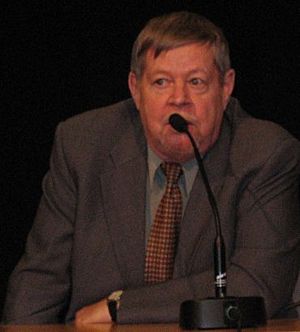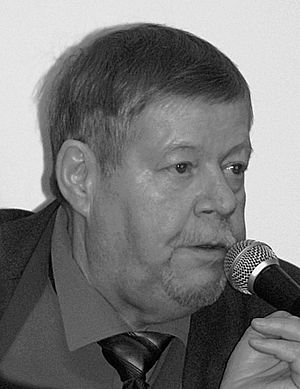Arto Paasilinna facts for kids
Quick facts for kids
Arto Paasilinna
|
|
|---|---|

October 2007 (aged 65), Helsinki Book Fair
|
|
| Born | 20 April 1942 Kittilä, Lapland, Finland |
| Died | 15 October 2018 (aged 76) Espoo, Finland |
| Occupation | journalist, novelist, poet |
| Citizenship | Finland |
| Education | Adult Education College, Lapland (1962-1963) |
| Period | since 1972 (fiction) since 1964 (non-fiction) |
| Genre | picaresque, comedy, satire |
| Notable works | The Year of the Hare (1975) The Howling Miller (1981) |
| Notable awards | Air Inter (France) 1989 The Year of the Hare Acerbi (Italy) 1994 The Year of the Hare |
| Relatives | Erno Paasilinna (brother) Reino Paasilinna (brother) |
Arto Tapio Paasilinna (Finnish: [ˈɑrto ˈpɑːsiˌlinːɑ], approximately ar-TOH-_-PAH-see-LEEN-nah; 20 April 1942 – 15 October 2018) was a famous Finnish writer. He started his career as a journalist but became well-known for his funny novels.
Arto Paasilinna was one of Finland's most successful writers. His books were popular not just in Finland but also around the world. They have been translated into 27 languages, and over seven million copies have been sold. Many people believe he helped make books from Finland more popular globally.
He is best known for his 1975 novel The Year of the Hare. This book was a bestseller in France and Finland. It won three international awards and was made into two movies. One was a Finnish film in 1977, and the other was a French film in 2006.
Arto Paasilinna had several brothers who were also writers: Erno Paasilinna, Reino Paasilinna, and Mauri Paasilinna.
Contents
Early Life and Family
Arto Paasilinna was born on April 20, 1942. His birthplace was Kittilä, a town in Lapland, Finland. His parents were Väinö and Hilda-Maria Paasilinna.
He was one of seven children in his family. He had four brothers and two sisters. Some of his siblings also became well-known. His brother Erno Paasilinna was a writer. Another brother, Reino Paasilinna, was a writer, a TV personality, and even a member of the European Parliament. His sister Sirpa Paasilinna-Schlagenwarth became a painter, and his brother Mauri Paasilinna was also a writer.
Arto Paasilinna studied at the Lapland Folk Academy, which is a type of adult education college.
Writing Career
Arto Paasilinna began his career as a journalist. He worked for different magazines and newspapers as a writer and editor. From 1968 to 1970, he was an editor at the weekly magazine Apu. Later, from 1975 to 1988, he wrote columns for the same magazine.
In 1975, when he was 33 years old, Paasilinna felt that journalism was becoming "superficial." He wanted to try something new. That summer, he sold his boat to get money to write his first novel, The Year of the Hare.
The book was a huge success right away. After that, Arto Paasilinna became a full-time writer. He was able to support himself by writing novels. He signed with the Finnish publisher WSOY in 1977. Even though he was a novelist, he still wrote articles for newspapers and was a columnist on Finnish radio.
By 2009, Paasilinna had written about 12 non-fiction books and 35 novels. He wrote almost one novel every year from 1972 to 2009. His publishers used to say that "The annual Paasilinna is as much an element of the Finnish autumn as falling birch leaves." This shows how regularly his new books came out.
His books are always being translated into new languages. At least 18 of his books have been translated into 27 different languages. For example, 17 of his books are in Italian, 16 in German, and 11 in French. The Finnish newspaper Helsingin Sanomat called him "The brightest star in the Finnish translated-literature firmament." His publisher, WSOY, said his success helped create a lot of interest in books from Finland.
Paasilinna's Writing Style
Paasilinna's books often show everyday Finnish life. They usually follow a middle-aged man living in rural Finland. His stories are fast-paced, light, and full of humor. Many of them are like picaresque adventure stories. This means they follow a clever hero who travels around and has many adventures.
His novels often make fun of modern life in a gentle way. Some of his stories are like modern fables. For example, The Year of the Hare is about a former journalist named Vatanen. He leaves his city life to find a more real way of living in the Finnish countryside. He takes an injured young hare with him and helps it get better. As he does this, he realizes how unhappy he was with his old city life.
Another one of his novels, Paratiisisaaren Vangit (which means "Prisoners of Paradise"), is a funny story about a UN plane that crashes on a deserted Pacific island. The passengers are a mix of people like lumberjacks, nurses, and midwives. Like The Year of the Hare, the story is told by a journalist. The people on the island are from different countries, like Finland, Sweden, Norway, and England. Paasilinna uses this to make jokes about different languages and national stereotypes. The castaways create their own society where people work for the group. They even have a jungle café that gives out alcohol in exchange for work. They soon find out they are not alone on the island and try to find a way to get help.
Two of his novels, Lentävä kirvesmies and Rovasti Huuskosen petomainen miespalvelija, were even turned into graphic novels by Hannu Lukkarinen.
Books Made into Movies
Many of Arto Paasilinna's books have been made into movies. Some of these films have even been dubbed into English. Here are some of them:
- 1977: Jäniksen vuosi / The Year of the Hare (based on the 1975 novel)
- 1982: Ulvova mylläri / The Howling Miller (based on the 1981 novel)
- 1986: Hirtettyjen kettujen metsä (based on the 1983 novel)
- 1996: Elämä lyhyt, Rytkönen pitkä (based on the 1991 novel)
- 2002: Kymmenen riivinrautaa (based on the 2001 novel)
- 2006: Le Lièvre de Vatanen (French for "Vatanen's Hare", based on the 1975 novel)
Later Life
In October 2009, Arto Paasilinna became very ill and needed to go to the hospital. In April 2010, he moved to a special home for recovery. His son was put in charge of his finances. Arto Paasilinna passed away on October 15, 2018, in a nursing home in Espoo, Finland.
See also
 In Spanish: Arto Paasilinna para niños
In Spanish: Arto Paasilinna para niños


